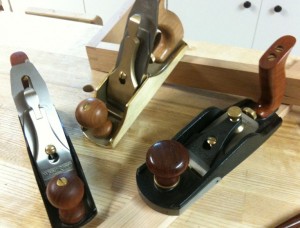Smoothing Plane Options
 Several months ago I did a head to head review of Lie Nielsen vs WoodRiver hand planes. I followed this up with a bevel up vs bevel down discussion. I have gotten a few emails asking about my thoughts several months later on WoodRiver planes. Additionally, my Hand Tool School students have been seeing my Lie Nielsen smoother in my hand a lot more than my Veritas bevel up smoother. This has brought up even more questions about which is my favorite and what I do with all of these smoothing plane options.
Several months ago I did a head to head review of Lie Nielsen vs WoodRiver hand planes. I followed this up with a bevel up vs bevel down discussion. I have gotten a few emails asking about my thoughts several months later on WoodRiver planes. Additionally, my Hand Tool School students have been seeing my Lie Nielsen smoother in my hand a lot more than my Veritas bevel up smoother. This has brought up even more questions about which is my favorite and what I do with all of these smoothing plane options.
The truth is I don’t have a favorite smoothing plane. I use them all.
My Veritas bevel up with the 50 degree blade has no respect for tear out and really doesn’t care about grain direction either. I have it set to take the thinnest of thin shavings and the mouth is so tight it traps light like a black hole. This is my “ace in the hole” for figured woods and ornery jungle species. The drawback is it is heavy and takes a lot of oomph to get it moving because of the high bevel angle.
My Bronze #4 Lie Nielsen has made a lot of appearance on my podcast of late and rarely leaves my hand while filming Hand Tool School lessons. Because of this, many may think this is my smoothing plane of choice. The reality is that 95% of the time I work with hand tool friendly woods with straight grain and medium hardness. The Lie Nielsen is set to take about a 2 thou shaving, has a tight mouth, and leaves a mirror surface in just about every board I encounter. This plane gets used a lot because the woods it’s current configuration tackles are what I use most in my projects. It is decidedly easier to push than the high angle bevel up Veritas.
My #3 WoodRiver plane has a smaller footprint than any of the above. It can take a very fine shaving, but I have set it up for a heavy fine shaving. Less than my Jack or Jointer, but much more than my other smoothers. This plane is great for removing saw marks and taking a board or panel to finished dimension. If the surface left is ready for finish then that is just less work I have to do later. If I tried to use one of my ultra fine set smoothers then multiple passes would be necessary to remove saw marks from even the finest pitch panel saws. In many furniture projects, your parts can be small and narrow and this #3 is perfect for cleaning them up. For a larger part, a Jack plane or even a Jointer can be the right tool but that is a topic for a different post.
Finally, I have a standard angle block plane by Veritas that is set much the same way as my WoodRiver #3. It will clean up a surface nicely and make it ready for finish but it does it quicker than the smoothers and it can be wielded with one hand. The agility of this plane makes it perfect for working on assembled casework or on really small parts where a precise and delicate touch is needed.
I’m really heading in a more minimalistic direction with my tooling these days, I firmly believe that beautiful furniture can be built with very few tools. Your shop is less crowded, your wallet is heavier, and you worry less about the next tool and more about working wood. So this post may seem a little contrary to that point as I have just stated that I have 4 planes that all can do the same job. (I actually have a few more I didn’t mention for brevity purposes) Truly, each one of these planes can be set up multiple ways to tackle just about any finish planing. I find that having multiple smoothing plane options has made me a more efficient woodworker. Stopping to readjust a plane for a small task then adjusting it back to where you had it takes time and when you are in the heat of a project these adjustments get forgotten.
On the converse, having multiple planes tuned differently means you can quickly reach for one when the situation arises and your results are better, more accurate, and achieved in less time. When done, that “specialty” plane goes back on the shelf and you resume work with your utility plane. The best news is that the other specially tuned versions wear very slowly so you set them up and they stay sharp for a long time.
So, yes, maybe I have a plane problem that dovetails nicely with my saw problem. I prefer to think of it as I have a desire to be more efficient.


